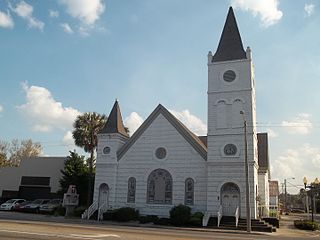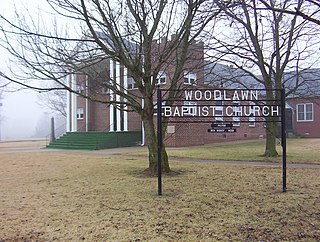
Lauderdale County is a county located on the western edge of the U.S. state of Tennessee, with its border the Mississippi River. As of the 2020 census, the population was 25,143. Its county seat is Ripley. Since the antebellum years, it has been developed for cotton as a major commodity crop.

Haywood County is a county located in the U.S. state of Tennessee, in the region known as West Tennessee. As of the 2020 census, the population was 17,864. Its county seat and largest city is Brownsville. It is one of only two remaining counties in Tennessee, along with Shelby County, with a majority African-American population.

Newbern is a town in Hale County, Alabama, United States. As of the 2020 census, the population of the town was 133.

Brownsville is a city in and the county seat of Haywood County, Tennessee, United States. Its population as of the 2020 census was 9,788. The city is named after General Jacob Jennings Brown, an American officer of the War of 1812.

The black church is the faith and body of Christian denominations and congregations in the United States that predominantly minister to, and are also led by African Americans, as well as these churches' collective traditions and members. The term "black church" may also refer to individual congregations, including in traditionally white-led denominations.
Woodlawn Cemetery is the name of several cemeteries, including:

"Nutbush City Limits" is a semi-autobiographical song written by Tina Turner which commemorates her rural hometown of Nutbush in Haywood County, Tennessee, United States. Originally released as a single on United Artists Records in August 1973, it is one of the last hits that husband-wife R&B duo Ike & Tina Turner released together.

Woodlawn Baptist Church and Cemetery, also known as Woodlawn Missionary Baptist Church, is a historic building in Nutbush, Haywood County, Tennessee, in the United States. It is on Woodlawn Road, south of Tennessee State Route 19.

Trinity United Methodist Church in Nutbush, Haywood County, Tennessee was founded in 1822. Planters allowed their slaves to attend church with them.

Religion of black Americans refers to the religious and spiritual practices of African Americans. Historians generally agree that the religious life of black Americans "forms the foundation of their community life". Before 1775 there was scattered evidence of organized religion among black people in the Thirteen Colonies. The Methodist and Baptist churches became much more active in the 1780s. Their growth was quite rapid for the next 150 years, until their membership included the majority of black Americans.

State Route 19 or the Tina Turner Highway is a state highway in Haywood and Lauderdale counties in Tennessee, United States. State Route 19 is 42.81 mi (69 km) long.

Golddust is a rural unincorporated community in Lauderdale County, Tennessee, United States. It is located on the banks of the Mississippi River. Golddust is one of the earliest European-American settlements in Lauderdale County.

State Route 180 is a secondary south–north highway in Haywood and Lauderdale Counties, Tennessee, United States. State Route 180 is 12.52 mi (20.1 km) long.
Flagg Grove School was a school south of Nutbush in Haywood County, Tennessee, now part of Brownsville. The school was established in the late 19th century and now operates as the Tina Turner Museum.

Roger Williams University was a historically black college in Nashville, Tennessee. It was founded in 1866 as the Nashville Normal and Theological Institute by the American Baptist denomination, which established numerous schools and colleges in the South. Renamed for Roger Williams, the founder of the First Baptist Church in America, it became the largest Baptist college in the area for educating African Americans. It was founded in a period when Protestant mission groups sponsored numerous educational facilities for freedmen in the South.
Durhamville is a rural unincorporated community in Lauderdale County, Tennessee, United States. Durhamville is the second oldest town in Lauderdale County. It was founded by Colonel Thomas Durham in 1829 or 1830. Thomas Durham owned a store in the town since 1826.

First Baptist Church was the first Baptist church in Petersburg, Virginia; one of the first African-American Baptist congregations in the United States, and one of the oldest black churches in the nation. It established one of the first local schools for black children in the nation.

Franklin is an unincorporated community located in Holmes County, Mississippi. Mississippi Highway 17 passes through Franklin, which is approximately 7 miles (11 km) south of Lexington, the county seat, and approximately 12 miles (19 km) north of the town of Pickens.

The First African Baptist Church of Richmond, Virginia is a Baptist Church. Founded in 1841, its members included both slaves and freedmen. It has since had a major influence on the local black community. At one point, it was one of the largest Protestant churches in the United States.
The First Baptist Church of Fincastle, Virginia was started in October 1831 by slaves in Fincastle, Virginia in Botetourt County, Virginia.
























